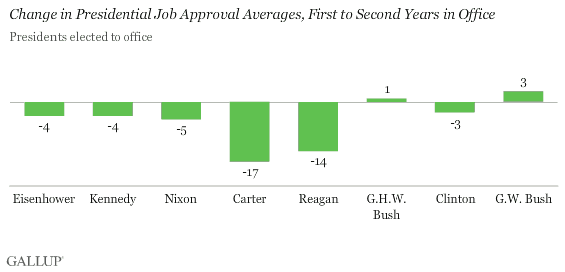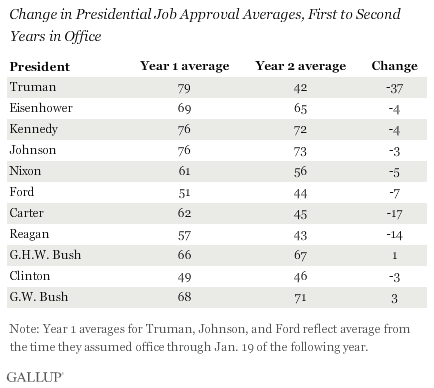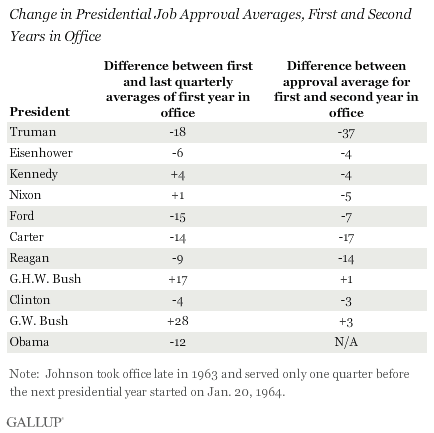PRINCETON, NJ -- Most of the last eight elected U.S. presidents, starting with Dwight Eisenhower, saw their approval rating drop in the second year of their presidency -- on average by five percentage points. According to Gallup historical data, only George H.W. Bush and George W. Bush avoided a second-year drop; Jimmy Carter and Ronald Reagan experienced the greatest declines in public approval from year one to year two.

"Thus, it appears that if significant momentum in either direction is established over the course of a president's first year in office, that momentum has carried over into the second year."
The average first-year to second-year drop is slightly higher -- eight points -- if presidents who were not elected to office are included in the analysis. This is mainly due to a steep drop totaling 37 points (from 79% to 42%) for Harry Truman. Truman took office upon the death of Franklin Roosevelt in 1945 and presided over the successful conclusion of World War II before domestic challenges -- including high inflation and widespread labor strife -- took on greater importance in 1946. Lyndon Johnson (three points) and Gerald Ford (seven points) had more typical second year declines.

Barack Obama begins the second year of his presidency Wednesday after averaging 57% job approval during his first year in office. But his recent approval ratings have generally hovered around the 50% mark, with his fourth quarter average (spanning Oct. 20 through Jan. 19) at 51%.
This decline in Obama's approval rating over the first year of his presidency is not an auspicious sign for his second year, based on historical patterns in Gallup's data. The presidents who experienced the greatest declines in support from their first to second year in office had already shown clear signs of decay over the course of their first years in office (based on a comparison of their first and last quarterly approval averages of their first year in office).
Specifically, Truman, Carter, Reagan, and Ford, who showed the four biggest declines in approval from their first to second years in office, also showed the biggest declines from the initial to the final quarter of their first year in office.
In contrast, the two Bushes -- who had higher average approval ratings their second year in office than in their first year-- showed significant gains in public support over the course of their first year.
Thus, it appears that if significant momentum in either direction is established over the course of a president's first year in office, that momentum has carried over into the second year. However, two of the presidents who had difficult second years -- namely, Truman and Reagan -- were able reverse that momentum in time to win re-election.

If Obama's support declines over the next 12 months, he could very well average below 50% job approval for his second year in office. That would not be unusual, as several recent presidents had approval ratings in the 40s their second year in office, including Truman, Ford, Carter, Reagan, and Bill Clinton.
The obvious political peril for Obama -- as was the case for Truman, Carter, Reagan, and Clinton -- is that his second year coincides with midterm congressional elections. When presidents' approval ratings have been below 50% in a midterm election year, their party has tended to suffer heavier seat losses.
As was the case with his first year in the Oval Office, Obama faces a list of serious challenges. In fact, a recent USA Today/Gallup poll found 63% of Americans saying the challenges Obama faced when he became president were more serious than those confronting other new presidents when they took office. Obama's ability to successfully meet these challenges -- which probably begins with improving the economy and reducing unemployment -- will help determine the trajectory of his second-year approval rating.
